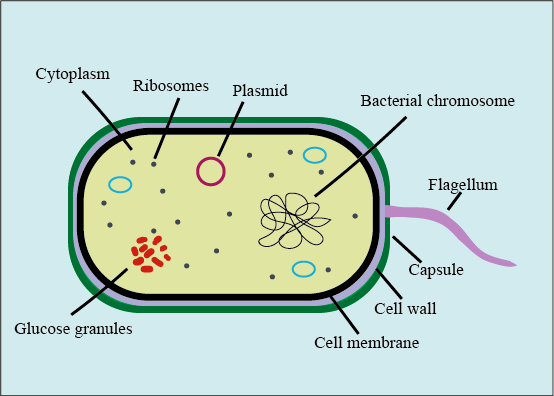
The term glycocalyx is used for
(a) The cell wall of bacteria
(b) Bacterial cell wall glycoengineered to possess N-glycosylated proteins
(c) A layer surrounding the cell wall of bacteria
(d) A layer present between the cell wall and cell membrane
Answer
455.4k+ views
Hint: Bacterial cells with glycocalyx are almost invisible to the host immune system and also helps in the adhesion to the living tissue.
Complete answer:
A carbohydrate-protein layer that is covered on many of the eukaryotic cells and prokaryotic cells is called the glycocalyx. In prokaryotes particularly it is covered on the cell wall of bacteria. Many of the eukaryotic cells use glycocalyx to recognize the cell. To protect from the host factors bacterial cells are covered with glycocalyx. The glycocalyx in bacterial cells has the ability to establish an infection.
Additional information:
- In bacteria glycocalyx is of several forms: the glycocalyx is called capsule if it is attached tightly to the underlying cell wall in a condensed form. If the glycocalyx is loosely attached to the cell wall and easily removable, it is called the slime layer.

- The structure of glycocalyx varies from bacteria to bacteria depending on the availability of nutrients and growth conditions. Generally, it is made up of sugars called saccharides. If more than two sugars are present then the glycocalyx is said to be made up of polysaccharide. In some glycocalyx, proteins are also present.
So, the correct answer is ‘(c) A layer surrounding the cell wall of bacteria’.
Note: The two important functions of glycocalyx are:
- It covers the bacterial cell and hides them from the immune system of the host. Bacteria with glycocalyx are almost invisible to the bacteria.
- Biofilms are formed by the bacterial cell to promote adhesion of the bacterial cells to the living tissue.
Complete answer:
A carbohydrate-protein layer that is covered on many of the eukaryotic cells and prokaryotic cells is called the glycocalyx. In prokaryotes particularly it is covered on the cell wall of bacteria. Many of the eukaryotic cells use glycocalyx to recognize the cell. To protect from the host factors bacterial cells are covered with glycocalyx. The glycocalyx in bacterial cells has the ability to establish an infection.
Additional information:
- In bacteria glycocalyx is of several forms: the glycocalyx is called capsule if it is attached tightly to the underlying cell wall in a condensed form. If the glycocalyx is loosely attached to the cell wall and easily removable, it is called the slime layer.

- The structure of glycocalyx varies from bacteria to bacteria depending on the availability of nutrients and growth conditions. Generally, it is made up of sugars called saccharides. If more than two sugars are present then the glycocalyx is said to be made up of polysaccharide. In some glycocalyx, proteins are also present.
So, the correct answer is ‘(c) A layer surrounding the cell wall of bacteria’.
Note: The two important functions of glycocalyx are:
- It covers the bacterial cell and hides them from the immune system of the host. Bacteria with glycocalyx are almost invisible to the bacteria.
- Biofilms are formed by the bacterial cell to promote adhesion of the bacterial cells to the living tissue.
Recently Updated Pages
Glucose when reduced with HI and red Phosphorus gives class 11 chemistry CBSE

The highest possible oxidation states of Uranium and class 11 chemistry CBSE

Find the value of x if the mode of the following data class 11 maths CBSE

Which of the following can be used in the Friedel Crafts class 11 chemistry CBSE

A sphere of mass 40 kg is attracted by a second sphere class 11 physics CBSE

Statement I Reactivity of aluminium decreases when class 11 chemistry CBSE

Trending doubts
10 examples of friction in our daily life

The correct order of melting point of 14th group elements class 11 chemistry CBSE

Difference Between Prokaryotic Cells and Eukaryotic Cells

One Metric ton is equal to kg A 10000 B 1000 C 100 class 11 physics CBSE

State and prove Bernoullis theorem class 11 physics CBSE

What organs are located on the left side of your body class 11 biology CBSE




